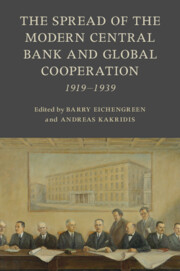Book contents
- The Spread of the Modern Central Bank and Global Cooperation
- Studies in Macroeconomic History
- The Spread of the Modern Central Bank and Global Cooperation
- Copyright page
- Contents
- Figures
- Tables
- Editors and Contributors
- Preface
- Part I General
- Part II Specific
- 5 Central Bank Policy under Foreign Control
- 6 Sneaking Nationalization
- 7 The Bank of Poland and Monetary Policy during the Interwar Period
- 8 From Banking Office to National Bank
- 9 ‘Nobody’s Child’
- 10 The Bulgarian National Bank, 1926–1935
- 11 Macroeconomic Policies and the New Central Bank in Turkey, 1929–1939
- 12 Latin American Experiments in Central Banking at the Onset of the Great Depression
- 13 Central Banks in the British Dominions in the Interwar Period
- 14 Central Banking and Colonial Control
- Index
- References
5 - Central Bank Policy under Foreign Control
The Austrian National Bank in the 1920s
from Part II - Specific
Published online by Cambridge University Press: 02 November 2023
- The Spread of the Modern Central Bank and Global Cooperation
- Studies in Macroeconomic History
- The Spread of the Modern Central Bank and Global Cooperation
- Copyright page
- Contents
- Figures
- Tables
- Editors and Contributors
- Preface
- Part I General
- Part II Specific
- 5 Central Bank Policy under Foreign Control
- 6 Sneaking Nationalization
- 7 The Bank of Poland and Monetary Policy during the Interwar Period
- 8 From Banking Office to National Bank
- 9 ‘Nobody’s Child’
- 10 The Bulgarian National Bank, 1926–1935
- 11 Macroeconomic Policies and the New Central Bank in Turkey, 1929–1939
- 12 Latin American Experiments in Central Banking at the Onset of the Great Depression
- 13 Central Banks in the British Dominions in the Interwar Period
- 14 Central Banking and Colonial Control
- Index
- References
Summary
The Bank of England and its governor, Montagu Norman, who had a decisive influence on monetary reconstruction after the First World War considered the new Austrian central bank too accommodating of Viennese banks, which clung to a prewar business strategy no longer appropriate to the economic environment. The fraught relationship between the Bank of England and the Austrian National Bank limited Austrian access to the London capital market. Thus, much-needed long-term capital for restructuring and modernizing of the Austrian economy was not available in the quantities needed, only short-term deposits that were not rolled-over after the outbreak of the financial crisis in 1931. Austrian National Bank President Reisch was replaced in 1932 by Viktor Kienböck, a former minister of finance who then masterminded Austrian economic policy until the German invasion in 1938. In accordance with the League of Nations, which guaranteed a second international bond of Austria in 1932, Kienböck adhered to the orthodox economic policy paradigm, rigorously defending the currency in the face of growing overvaluation. As a result, Austria’s economy shrank, and by 1937 its GDP stood 14% below its level of 1929.
Keywords
- Type
- Chapter
- Information
- The Spread of the Modern Central Bank and Global Cooperation1919–1939, pp. 105 - 138Publisher: Cambridge University PressPrint publication year: 2023

